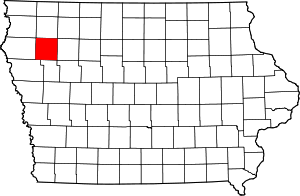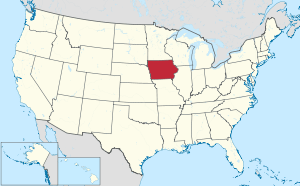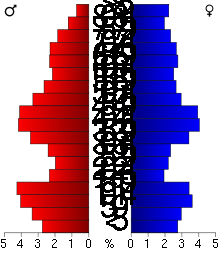Cherokee County, Iowa
Cherokee County is a county located in the U.S. state of Iowa. As of the 2010 census, the population was 12,072.[1] The county seat is Cherokee.[2] The county was formed on January 15, 1851 from open territory. It was named after the Cherokee Indians.
Cherokee County | |
|---|---|
Cherokee County Courthouse, July 2014 | |
 Location within the U.S. state of Iowa | |
 Iowa's location within the U.S. | |
| Coordinates: 42°44′05″N 95°37′27″W | |
| Country | |
| State | |
| Founded | 1851 |
| Named for | Cherokee people |
| Seat | Cherokee |
| Largest city | Cherokee |
| Area | |
| • Total | 577 sq mi (1,490 km2) |
| • Land | 577 sq mi (1,490 km2) |
| • Water | 0.2 sq mi (0.5 km2) 0.03% |
| Population (2010) | |
| • Total | 12,072 |
| • Estimate (2018) | 11,321 |
| • Density | 21/sq mi (8.1/km2) |
| Time zone | UTC−6 (Central) |
| • Summer (DST) | UTC−5 (CDT) |
| Congressional district | 4th |
| Website | www |
Geography
According to the U.S. Census Bureau, the county has a total area of 577 square miles (1,490 km2), of which 577 square miles (1,490 km2) is land and 0.2 square miles (0.52 km2) (0.03%) is water.[3]
Major highways
.svg.png)




Adjacent counties
- O'Brien County (north)
- Buena Vista County (east)
- Ida County (south)
- Woodbury County (southwest)
- Plymouth County (west)
Demographics
| Historical population | |||
|---|---|---|---|
| Census | Pop. | %± | |
| 1860 | 58 | — | |
| 1870 | 1,967 | 3,291.4% | |
| 1880 | 8,240 | 318.9% | |
| 1890 | 15,659 | 90.0% | |
| 1900 | 16,570 | 5.8% | |
| 1910 | 16,741 | 1.0% | |
| 1920 | 17,760 | 6.1% | |
| 1930 | 18,737 | 5.5% | |
| 1940 | 19,258 | 2.8% | |
| 1950 | 19,052 | −1.1% | |
| 1960 | 18,598 | −2.4% | |
| 1970 | 17,269 | −7.1% | |
| 1980 | 16,238 | −6.0% | |
| 1990 | 14,098 | −13.2% | |
| 2000 | 13,035 | −7.5% | |
| 2010 | 12,072 | −7.4% | |
| Est. 2018 | 11,321 | [4] | −6.2% |
| U.S. Decennial Census[5] 1790-1960[6] 1900-1990[7] 1990-2000[8] 2010-2018[1] | |||
2010 census
The 2010 census recorded a population of 12,072 in the county, with a population density of 21.254/sq mi (8.206/km2). There were 5,777 housing units, of which 5,207 were occupied.[9]
2000 census

As of the census[10] of 2000, there were 13,035 people, 5,378 households, and 3,597 families residing in the county. The population density was 23 people per square mile (9/km²). There were 5,850 housing units at an average density of 10 per square mile (4/km²). The racial makeup of the county was 98.33% White, 0.31% Black or African American, 0.16% Native American, 0.43% Asian, 0.37% from other races, and 0.40% from two or more races. 0.95% of the population were Hispanic or Latino of any race.
There were 5,378 households out of which 29.10% had children under the age of 18 living with them, 57.30% were married couples living together, 6.50% had a female householder with no husband present, and 33.10% were non-families. 29.50% of all households were made up of individuals and 15.30% had someone living alone who was 65 years of age or older. The average household size was 2.35 and the average family size was 2.91.
In the county, the population was spread out with 24.60% under the age of 18, 6.80% from 18 to 24, 24.00% from 25 to 44, 24.30% from 45 to 64, and 20.40% who were 65 years of age or older. The median age was 42 years. For every 100 females there were 97.40 males. For every 100 females age 18 and over, there were 92.70 males.
The median income for a household in the county was $35,142, and the median income for a family was $42,897. Males had a median income of $29,612 versus $21,181 for females. The per capita income for the county was $17,934. About 5.50% of families and 7.30% of the population were below the poverty line, including 9.70% of those under age 18 and 5.70% of those age 65 or over.
Communities
Townships
Cherokee County is divided into sixteen townships:
Population ranking
The population ranking of the following table is based on the 2010 census of Cherokee County.[11]
† county seat
| Rank | City/Town/etc. | Municipal type | Population (2010 Census) |
|---|---|---|---|
| 1 | † Cherokee | City | 5,253 |
| 2 | Marcus | City | 1,117 |
| 3 | Aurelia | City | 1,036 |
| 4 | Quimby | City | 319 |
| 5 | Washta | City | 248 |
| 6 | Cleghorn | City | 240 |
| 7 | Meriden | City | 159 |
| 8 | Larrabee | City | 132 |
Politics
| Year | Republican | Democratic | Third Parties |
|---|---|---|---|
| 2016 | 67.0% 4,192 | 26.8% 1,679 | 6.2% 387 |
| 2012 | 57.1% 3,662 | 41.1% 2,634 | 1.9% 119 |
| 2008 | 53.0% 3,372 | 45.4% 2,890 | 1.7% 106 |
| 2004 | 55.3% 3,758 | 44.0% 2,988 | 0.7% 50 |
| 2000 | 52.5% 3,463 | 43.2% 2,845 | 4.3% 284 |
| 1996 | 41.3% 2,629 | 44.8% 2,853 | 13.9% 888 |
| 1992 | 40.2% 2,768 | 37.6% 2,590 | 22.3% 1,535 |
| 1988 | 46.9% 3,218 | 52.1% 3,574 | 0.9% 63 |
| 1984 | 54.2% 4,046 | 44.8% 3,349 | 1.0% 75 |
| 1980 | 54.5% 4,087 | 36.3% 2,719 | 9.3% 694 |
| 1976 | 53.4% 3,993 | 44.9% 3,358 | 1.7% 127 |
| 1972 | 62.2% 4,726 | 36.6% 2,780 | 1.2% 88 |
| 1968 | 59.2% 4,436 | 36.1% 2,705 | 4.7% 355 |
| 1964 | 42.3% 3,180 | 57.6% 4,336 | 0.1% 9 |
| 1960 | 59.1% 4,791 | 40.8% 3,309 | 0.1% 6 |
| 1956 | 59.7% 4,821 | 40.3% 3,254 | 0.1% 4 |
| 1952 | 70.5% 6,018 | 29.3% 2,502 | 0.3% 21 |
| 1948 | 46.4% 3,318 | 52.3% 3,739 | 1.2% 87 |
| 1944 | 53.6% 3,723 | 46.0% 3,197 | 0.4% 29 |
| 1940 | 53.5% 4,458 | 46.3% 3,855 | 0.2% 19 |
| 1936 | 37.0% 2,902 | 60.1% 4,716 | 2.9% 227 |
| 1932 | 34.8% 2,570 | 63.7% 4,701 | 1.5% 111 |
| 1928 | 58.9% 3,909 | 40.7% 2,701 | 0.4% 25 |
| 1924 | 52.3% 3,240 | 14.6% 904 | 33.1% 2,052 |
| 1920 | 77.7% 4,544 | 20.7% 1,211 | 1.6% 94 |
| 1916 | 48.3% 1,578 | 50.3% 1,646 | 1.4% 46 |
| 1912 | 12.3% 381 | 30.1% 930 | 57.6% 1,781 |
| 1908 | 66.1% 2,300 | 31.1% 1,084 | 2.8% 97 |
| 1904 | 74.6% 2,446 | 21.0% 688 | 4.4% 145 |
| 1900 | 63.1% 2,432 | 32.5% 1,253 | 4.4% 169 |
| 1896 | 60.1% 2,343 | 37.5% 1,464 | 2.4% 93 |
References
- "State & County QuickFacts". United States Census Bureau. Archived from the original on July 8, 2011. Retrieved July 14, 2014.
- "Find a County". National Association of Counties. Archived from the original on May 3, 2015. Retrieved June 7, 2011.
- "US Gazetteer files: 2010, 2000, and 1990". United States Census Bureau. February 12, 2011. Retrieved April 23, 2011.
- "Population and Housing Unit Estimates". Retrieved June 27, 2019.
- "U.S. Decennial Census". United States Census Bureau. Retrieved July 14, 2014.
- "Historical Census Browser". University of Virginia Library. Retrieved July 14, 2014.
- "Population of Counties by Decennial Census: 1900 to 1990". United States Census Bureau. Retrieved July 14, 2014.
- "Census 2000 PHC-T-4. Ranking Tables for Counties: 1990 and 2000" (PDF). United States Census Bureau. Retrieved July 14, 2014.
- "Population and Housing Occupancy Status: 2010 - State -- County". United States Census Bureau American FactFinder. Retrieved March 9, 2011.
- "U.S. Census website". United States Census Bureau. Retrieved January 31, 2008.
- "Archived copy". Retrieved February 10, 2013.
- Leip, David. "Dave Leip's Atlas of U.S. Presidential Elections". uselectionatlas.org. Retrieved April 25, 2018.
| Wikimedia Commons has media related to Cherokee County, Iowa. |
